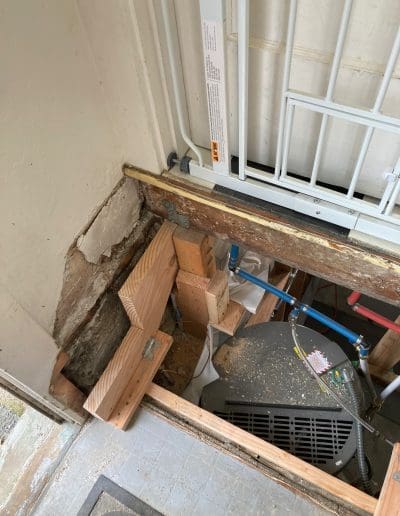Custom Stair Solutions
Stair Renovation
Oregon Stair Services
Sturdy & Stylish Stairs
A Local Staircase Renovation Company that Delivers Results

Expert Craftsmanship
Quality StairWay Renovation
Experience the pinnacle of stairway renovation and fixes with us – contact Stumptown Stairs today for unparalleled quality and craftsmanship.
Repairs You Can Trust
Quality Stair Rejuvination
Expert Craftsmanship
We Prefer








Stumptown Stairs employs only the finest materials and state-of-the-art tools to ensure each staircase is a masterpiece of quality and craftsmanship.
More Information
Guide to Modern Staircase Makeover
Material Choices
Materials play a vital role in the transformation of any staircase and should be a primary focal point of any Portland stair company. Hardwood remains a popular choice for its durability and timeless appeal. However, modern renovations often incorporate glass or metal for a sleeker look. These materials can brighten up the space and give stairs an airy feel.
Metal railings, combined with glass panels, create an illusion of more space. They allow light to flow freely across the area. Hardwood steps, on the other hand, add warmth and a classic touch.
Color Schemes
Choosing the right color scheme is crucial for a staircase makeover and it needs to compliment the shared space (living room, hallway, etc). Neutral tones like white, gray, or beige offer a minimalist aesthetic. They serve as a perfect backdrop for highlighting architectural details.
For those looking to make a bolder statement, dark hues such as black or navy can add dramatic flair. Painting the risers in contrasting colors or patterns can introduce personality without overwhelming the space.
Lighting Solutions
Proper lighting can transform a staircase remodel from purely functional to a standout feature of your home. LED strip lights under the handrail or along the steps provide both illumination and style.
Pendant lights or chandeliers hanging in multi-level stairwells add elegance and visual interest. They should complement the overall design theme of your home.
Materials for Staircase Renovation
Wood Options
Wood remains a top choice for staircase renovation due to its versatility and warmth. Hardwoods like oak, maple, and walnut are durable and can withstand heavy foot traffic. They offer a rich look that enhances the staircase’s appeal.
Pine is a cost-effective option but might not last as long as hardwoods. Each wood type brings its unique grain and color, allowing for customization.
Metal Accents
Metal accents in staircase renovations add a modern touch. Stainless steel and wrought iron are popular for their strength and design flexibility. These materials work well for handrails and balusters, providing a sleek contrast to wood stairs.
Aluminum is lighter and resistant to corrosion, making it suitable for outdoor staircases.
Stone Solutions
For those seeking luxury, stone steps elevate the staircase’s aesthetics. Marble, granite, and limestone are sought after for their beauty and durability. They require more investment but offer unparalleled elegance.
Stone is perfect for entryways or as accent pieces on landings.
Composite Materials
Composite materials like vinyl and fiberglass are gaining popularity for stair renovation. They mimic the look of wood or stone at a lower cost and require less maintenance. These materials resist wear, scratches, and moisture, making them ideal for high-traffic areas or outdoor use.
They come in various colors and styles, offering flexibility in design without compromising on durability.
Breaking Down Staircase Walls
Design Benefits
Breaking down staircase walls can transform a home’s interior. It creates an open, airy space, enhancing natural light flow. This stair renovation can make small areas appear larger.
Removing walls around a staircase introduces a modern aesthetic. It allows for creative design elements like glass railings or unique stair materials previously discussed. Homeowners enjoy the seamless transition between floors.
Structural Considerations
Before demolition, understanding the wall’s role is crucial. Some walls are load-bearing and require professional assessment to ensure house integrity remains intact.
Professionals can determine if additional support structures are necessary. They ensure the renovation adheres to building codes. Safety should never be compromised for aesthetics.
Cost Analysis
Cost varies widely based on the project’s complexity and materials chosen for the new staircase design. Removing walls involves labor, disposal, and potentially structural reinforcements.
Budgeting accurately prevents unexpected expenses during renovation. Consulting with experts helps homeowners make informed decisions about their investment.
Steps for Painting Stair Trims
Surface Prep
After breaking down staircase walls, it’s crucial to prepare the trims. First, clean them thoroughly. Use a mild detergent and water to remove dirt and grease.
Allow them to dry completely before proceeding. This step is vital for paint adhesion.
Sanding
Sanding smooths the surface. Start with a medium-grit sandpaper, then use a fine-grit for a polished finish.
Dust off any residue. A tack cloth works best for this task.
Primer Application
Apply a quality primer. It ensures paint durability and enhances color richness.
Let the primer dry according to the manufacturer’s instructions.
Paint Selection
Choose the right paint. For stair trims, semi-gloss or gloss finishes are ideal. They resist wear and tear better.
Consider the trim color carefully. It should complement the overall staircase aesthetic.
Painting Process
Start painting from the top down. This method prevents drips on freshly painted areas.
Use painter’s tape for sharp lines. Remove it before the paint dries completely to avoid peeling.
Apply two coats for even coverage. Allow ample drying time between coats.
Selecting a Modern Railing System
Material Choices
After enhancing stair trims with paint, choosing the right material for a modern railing system is crucial. Materials range from wood to metal and glass, each offering unique benefits.
Wood railings add warmth and traditional charm. They’re versatile and can be painted or stained to match any decor. Metal railings, on the other hand, offer sleek lines and durability. They are ideal for contemporary homes. Glass railings provide an unobstructed view and a sense of openness but require regular cleaning to maintain their clarity.
Design Considerations
The design of the railing system should complement the home’s overall aesthetic. For a cohesive look, consider the style of your freshly painted stair trims. Straight rails suit minimalist decors, while ornate designs fit classical themes. Cable systems are perfect for modern homes, offering clean lines without obstructing views. When selecting a design, think about safety requirements and building codes too.
Installation Process
Professional installation ensures the safety and longevity of your railing system. It involves measuring, cutting, and mounting components securely. DIY enthusiasts might tackle this project with care, but hiring experts is advisable for complex installations or when working with heavy materials like glass.
Setting Up Railing Posts & Rods
Post Installation
After choosing a modern railing system, the next step is setting up the posts. These are the foundation of any railing setup. It’s crucial to ensure they’re securely attached to the stair structure. First, mark the positions where each post will go. Use a level to make sure these marks are perfectly vertical. Then, drill holes for the anchors. The size and depth of these holes depend on your specific railing system and the material of your stairs. Once drilled, insert the anchors and attach the posts using bolts or screws. Check each post with a level again after installation to ensure they’re perfectly upright.
Rod Placement
With posts in place, it’s time to install the rods. This step transforms your staircase by adding the visual flair and safety features that come with a modern railing system. Measure the distance between posts accurately before cutting any rods to size. Remember, precision here prevents wasted materials and ensures a sleek finish. Slide each rod into place, securing them according to manufacturer instructions. This might involve clamping or screwing them into pre-drilled holes in each post. For an added touch of elegance or to match your home’s aesthetic, consider customizing rod finishes or colors. Stainless steel offers a contemporary look, while wrought iron can provide a classic feel.
Modern Handrail Installation Guide
Choosing Materials
After setting up railing posts and rods, selecting the right materials becomes crucial. Materials determine both aesthetic appeal and durability. Wood offers a classic look but requires regular maintenance. Metal, on the other hand, is more durable and offers a sleek, modern appearance. For those seeking a balance between aesthetics and longevity, composite materials might be the best choice.
Measuring Accurately
Accurate measurements are key to a seamless installation. It’s essential to measure the length of the area where the handrail will be installed. This ensures that the handrail fits perfectly without any unnecessary gaps or overhangs. Remember to account for the height of the handrail from the steps or floor to comply with local building codes.
Installation Process
The installation process involves several detailed steps. First, secure the brackets at predetermined intervals along the wall or posts. Ensure they are firmly attached to support the weight of the handrail and its users. Next, place the handrail atop these brackets, checking alignment before finalizing its position. Screwing or bolting it in place completes this phase of installation.
Final Touches
Adding final touches can significantly enhance your staircase renovation project. Consider sanding wooden handrails for a smooth finish or applying a coat of paint or varnish to match your home’s interior design. For metal handrails, periodic polishing keeps them looking new.
Wooden Flooring for Stairs Upgrade
Material Choices
Wooden flooring offers a timeless appeal that can significantly enhance the aesthetic of any staircase. Hardwoods like oak, maple, and walnut are popular for their durability and rich textures. They withstand heavy foot traffic while adding warmth to interiors. Choosing the right wood type is crucial. Each species has its unique color and grain pattern. Oak is renowned for its strength and classic look. Maple provides a lighter finish, ideal for modern spaces. Walnut adds a luxurious touch with its deep tones.
Installation Process
The transition from installing modern handrails to laying wooden flooring on stairs requires precision. Measuring each step accurately ensures that the wood planks fit perfectly. It’s essential to consider the tread and riser dimensions for a seamless installation. Professionals often recommend starting from the bottom step. This approach allows adjustments as you move upwards. Using quality adhesives and nails secures the planks in place, preventing creaks or shifts over time.
Maintenance Tips
Wooden stairs need regular care to maintain their beauty and longevity. Sweeping away dirt and dust prevents scratches on the surface. Using specific wood cleaners helps in preserving the natural luster without damaging the material. Avoiding water spills is vital as moisture can warp wood over time. Placing mats at entry points reduces wear on frequently used steps.
Overlooking Storage Solutions in Stairs
Hidden Drawers
Many homeowners miss the chance to add hidden drawers in their staircase renovation. These drawers offer extra storage without taking up more space. By incorporating hidden drawers, you can store shoes, tools, or seasonal items neatly. This solution keeps your home clutter-free and maximizes underutilized spaces.
Under-stair Closets
Under-stair closets are another overlooked option. They provide ample space for larger items like vacuum cleaners or sports equipment. Creating a closet under the stairs can transform an awkward area into a functional storage space. It’s an effective way to use every inch of your home wisely.
Pull-out Shelves
Pull-out shelves are perfect for storing smaller items. They make everything easily accessible and organized. Installing pull-out shelves can turn the dead space under your stairs into a handy mini pantry or cleaning supply storage. It’s a smart addition to any staircase renovation project.
Safety Considerations in Stair Updates
Material Choice
Choosing the right materials is crucial for ensuring stair safety. Non-slip surfaces are essential, especially in homes with children or elderly residents. Hardwood can be slippery, so adding carpet runners or anti-slip pads is a wise decision. Wood offers durability and a classic look but may require regular maintenance to prevent wear and tear. Metal stairs, on the other hand, provide modern aesthetics and strength but can be costly.
Handrail Design
Handrails are not just decorative; they’re a vital safety feature. They should be sturdy and comfortably graspable. The height of handrails must comply with local building codes, typically around 34 to 38 inches above the stair treads. Installing additional handrails on both sides of the staircase can significantly enhance safety for all users.
Lighting Enhancements
Proper lighting can prevent accidents on stairs. Ambient lighting ensures that each step is clearly visible, reducing the risk of missteps. LED strip lights along the sides or under the handrail offer both illumination and style. Consider motion sensors for added convenience and energy efficiency. These automatically light up the stairs when someone approaches, providing immediate visibility at any time of day.
Contact Us When it is Time to Renovate Your Stairs
This is a lot of information to take in… if you are looking for stair services is to contact us and we can discuss your goals and needs.
Transform your home with Stumptown Stairs’ expert stair remodel services. Whether you’re looking to upgrade your main staircase or renovate your basement stairs, we specialize in comprehensive staircase remodels that will enhance both beauty and functionality.
Let Stumptown Stairs take your staircase remodel to the next level. Our step-by-step renovation process ensures that your basement stairs or any staircase in your home becomes a stunning focal point. Schedule a consultation with our experts and see how we can make your vision a reality!
Related Topics
Stumptown Stairs
Get In Touch
Stumptown Stairs
CCB #218207
Making Stairs for the Greater Portland Area & Beyond
Operating Hours
M-F: 8am - 6pm
Sat: By appointment
Sun: Closed


